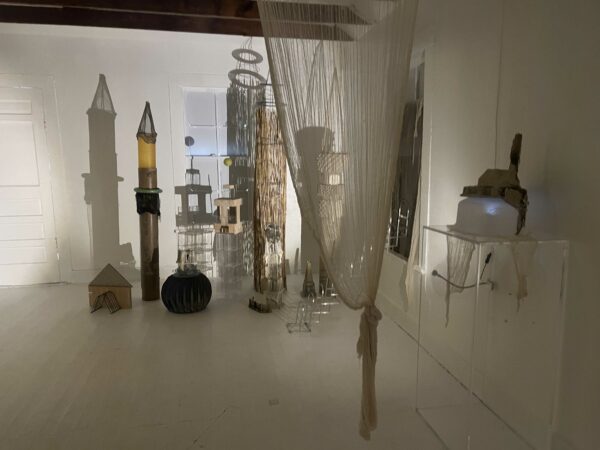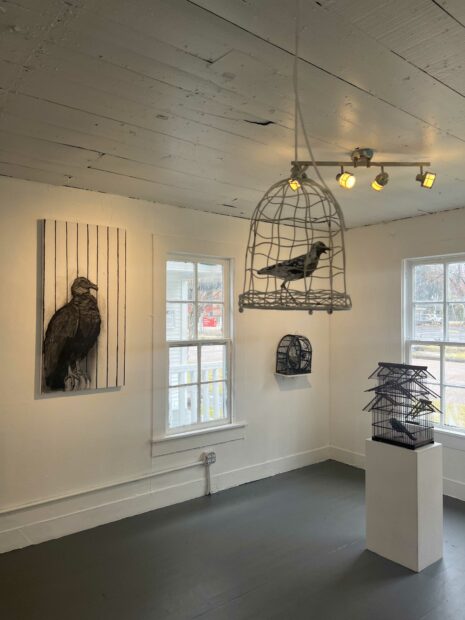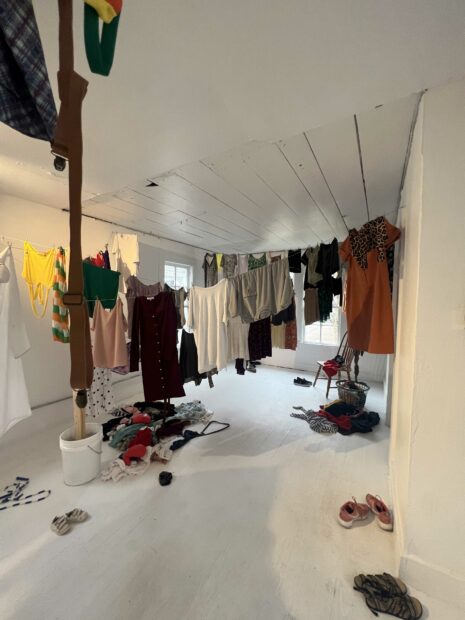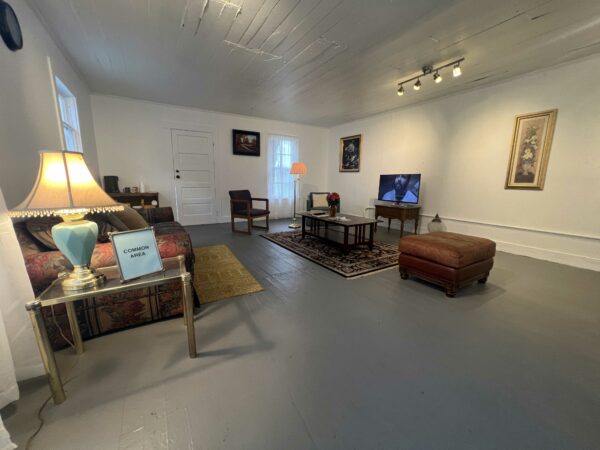
Installation View of work by Rehab El Sadek in “Round 54: Southern Survey Biennial” at Project Row Houses, Houston.
Project Row Houses has been a Houston institution for two decades, which is why it is no surprise that the art and community organization is forging the way towards more nuanced representations of the South. Helmed by guest curator Valerie Cassel Oliver, Round 54: Southern Survey Biennial celebrates artists from the following states: Texas, Louisiana, Arkansas, Mississippi, Alabama, Tennessee, Kentucky, Virginia, West Virginia, North Carolina, South Carolina, Georgia, and Florida. Eight artists installed their work in Project Row Houses’ properties, allowing viewers to float from room to room, concept to concept. The exhibition slots seamlessly into Project Row Houses’ five-block, 39-structure site in Houston’s Third Ward.
Stepping into Carlie Trosclair’s Floodplain, one gets the sense of a post-disaster quiet. Trosclair places flesh-like latex castings of domestic objects in the dimly-lit room. One encounters a two glowing chest of drawers stacked to look like a corset without a ribcage. A suspended antique armchair melts down the floor into a shape reminiscent of a chicken carcass. Each object hosts its ruined twin below it, a mirror image of the original in a state of decay. Being alone with these skin-like sculptures is unsettling, like being in someone else’s uncanny nightmare.
When explaining the work in the exhibition pamphlet, Trosclair evokes Toni Morrison’s The Site of Memory and her writing on the Mississippi River: “’Floods’ is the word they use, but in fact it is not flooding, it is remembering. Remembering where it used to be. All water has a perfect memory and is forever trying to get back to where it was.” This collision of disaster and memory points to the precarity of what we hold familiar. The pieces are inspired by Trosclair’s return to her hometown of New Orleans, where coastal erosion and hurricanes are a constant threat. In her artist statement she explains that the thin surfaces she works with “reshape the narrative of home as a sturdy secure space into one that is vulnerable and ephemeral.” Working with these traces, these symbols of belonging, is a kind of mourning, each piece a eulogy to a lost home.

Installation view of work by Sedrick Huckaby in “Round 54: Southern Survey Biennial” at Project Row Houses, Houston.
Rehab El Sadek’s Penumbra and Sedrick Huckaby’s Black Bird share a preoccupation with the built environment. Walking into Penumbra, one encounters warped everyday objects with a ghostly animacy — spinning conical wire cages draped in white gauze, mixed media columns, a miniature window embedded into exposed brick. For El Sadek, these built environments evoke the complexities of cultural identity. “I employ architectural structures, light, and shadow to stage dynamic reconstructions of a fading past subject to the emotions, fluctuations, and alterations of memory,” El Sadek explains in the exhibition pamphlet, “the layered reality of the immigrant experience.”
Sedrick Huckaby’s Black Bird shares a similar defamiliarized quality. The space is filled with melancholic newsprint papier-mâché birds in cages of various sizes and shapes. Many of the birds’ delicate beaks are driven into the cage. Others lay listless on their sides, as if they’ve run out of energy to fight their confines. Themed around the injustice of the mass incarceration of Black people, Huckaby asks viewers to consider psychological and spiritual imprisonment as well.

Installation view of work by Victoria Ravelo and Naomi Lemus in “Round 54: Southern Survey Biennial” at Project Row Houses, Houston.
Victoria Ravelo and Naomi Lemus’s Mumuration and Julien Hyvrard’s Tales from Transitional Space both evoke domestic space to make statements about collective care. In Mumuration, one encounters a tangle of clothing on a line, piled on the floor, and draped over a chair. There are tiny baby socks, a dilapidated ironing board, and an assorted pile of discarded curlers, implying a deeply lived-in space. Looking over the detritus and joys of home life (on the clothing line there is a prominently featured FLAWLESS graphic t-shirt), one cannot help but think of the many ecosystems that make up one’s own personal space and who we share it with.

Installation view of work by Julien Hyvrard in “Round 54: Southern Survey Biennial” at Project Row Houses, Houston.
Entering Tales from Transitional Space, I half expected someone to wander out of the bathroom brushing their teeth. The house feels inhabited, with shoes neatly placed by the bed, a sweater slung across a chair, the television still on. Begun as an experimental documentary filmed in Houston transitional homes built by Joe Donalson, who himself spent time in prison, the piece is a commentary on the need for transitional spaces for formerly incarcerated folks and aims to counteract the housing and social stigma that they face upon release.
Rashayla Marie Brown’s Tamara’s Repair: A Moving Image calls for justice and facilitates healing through re-imagining the archive. By employing the tenants of embodied therapy, the piece entangles the psychological, political, intellectual, and the creative. Mirrors, velvet, and red light envelop the space, accompanied by a soundscape and voice-over. The piece is a tribute to Tamara Lanier, who is currently suing Harvard University for emotional distress over photographs of her enslaved ancestors, Renty and Delia Taylor. “When a POC or femme subject is involved,” Maria Brown writes on her website, “the objectification process of a camera and three-act narrative structure of beginning, middle, and end leads to imprisonment, pseudo-pornographic portrayals of violence, and loss.” Evoking light sensitivity processes similar to EMDR (Eye Movement Desensitization and Reprocessing), used to treat PTSD, the installation becomes, as Maria Brown puts it, “a transformative space where we can witness an alternative to traumatic stories we cannot bear to witness.”

Installation wiew of work by Kandy G. Lopez in “Round 54: Southern Survey Biennial” at Project Row Houses, Houston.
Kandy G. Lopez’s (In)Visibility: SWAGGER is comprised of large-scale portraits meticulously rendered with yarn. The pieces are detailed and vivid, and at times the subjects pose confidently, while others are tender, with arms slung over one another, a cityscape in the background. The first piece, Marly (2022) (the title is noted next to the figure in pencil), at first glance looks like it is blocking the house’s entrance. Then, one looks down where a silhouette of the piece is echoed on the ground. Before stepping into the gallery one hesitates, trained not to touch the art. “Individuals may feel weird walking on the artwork,” Lopez’s artist statement reads, “but do they question their actions or non-actions when it comes to how POCs are being treated in this country?”
Round 54: Southern Survey Biennial is on view through February 12, 2023 at Project Row Houses in Houston.


